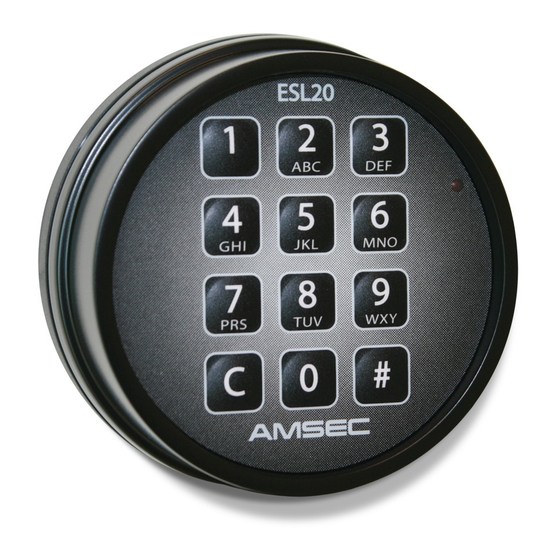AMSEC ESL20XL Instrukcja obsługi - Strona 9
Przeglądaj online lub pobierz pdf Instrukcja obsługi dla Zamki AMSEC ESL20XL. AMSEC ESL20XL 10 stron. Electronic lock

American Security Products Co.
The two most common causes of opening issues with the ESL20XL are as follows.
1. Weak or Dead Batteries.
This is the #1 cause of opening issues.
to input or lack of bolt actuation (clicking sound) after inputting your combo. The ESL20XL does not have
a low battery indication.
The ESL20XL uses two 9-volt alkaline batteries. The simple and reliable nature of the ESL20XL is centered
on a large Solenoid that requires high current delivery very quickly. Batteries that may appear to have a
good charge level may not have the capacity to deliver high current as they decay. Low quality batteries
tend to show poor performance when they are placed in demanding conditions like this.
If you have changed your batteries, and there is still no keypad response to input:
Remember to first press "C" when entering your combination
Make sure the cable has not become disconnected from the keypad. Remove the keypad and check
the connection to make sure the cable is securely installed in the socket. The locking tab should
engage, so that pulling on the cable will not dislodge the plug.
Make sure the Battery Contacts snap firmly onto the battery posts. A loose connection cannot deliver
high current.
2. Bolt Binding.
a. This is the second most common cause of opening issues. Bold binding occurs when the locking
mechanism (boltwork) presses on the locking bolt of the lock inside the door. The ESL20XL relies on
a solenoid to actuate this bolt. That solenoid can only overcome so much resistance, and if that
resistance is too great, the bolt does not retract.
To resolve this problem, you must find a handle position that does not push the locking system up
against the lock's bolt. To find that place, it helps to know which way the handle turns when you open
the door.
If your handle turns clockwise to open, turn the handle all the way counterclockwise before attempting
to open the lock.
If your handle turns counterclockwise to open, turn the handle all the way clockwise before attempting
to open the lock.
If you don't remember which way your handle turns, you can find the center of the free-play. Move
the handle clockwise and counterclockwise to the stopping points to find the range of motion. Then,
move the handle to the center of that range before actuating the lock.
If the bolt pressure is causing the problem you are experiencing, this should solve that problem. Once
you figure this out, make it a habit to position the handle in the best position when you leave the safe
so it's ready for the next time you open it.
b. If you have persisting intermittent opening success, and changing the batteries seems to make it better
for a while, there may be a bolt binding condition in the Boltwork that should be corrected. Many assume
the Batteries are getting drained at an abnormal rate, but in reality it is taking all the power of fresh
batteries to reliably overcome the binding. This would be evident because you can't find a sweet-spot to
position the handle to allow the lock bolt complete freedom to operate, and replacing the batteries seems
to resolve the issue temporarily.
Revision A
ESL20XL Operating Instructions
Symptoms of a low battery can include lack of keypad response
Page 9 of 10
Released Aug. 9, 2018
